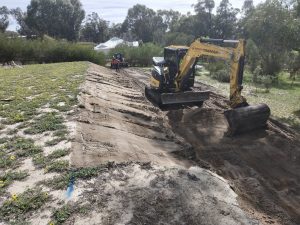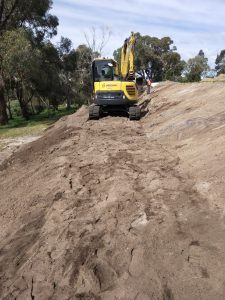Excavators are commonly used in construction projects due to their ability to dig trenches, pits, and foundations. Also, they are available in different types and sizes, offering you more alternatives for using an excavator that is ideal for your needs.
In most cases, the topographical condition of the project will often define the type of excavator you will need to use. Nevertheless, you don’t always get to operate on flat, smooth terrain; sometimes you have to deal with hills or even sharp angles.
Working with any type of machinery on some steep terrain will surely demand specific abilities and perhaps additional tools. Continue reading to learn everything you need to know about working with an excavator on a slope.
Critical factors while operating an excavator on a slope
Gravity is the most crucial thing to consider in this scenario. As we all know, the machine’s centre of gravity alters as it turns from side to side. As a result, the risk of overturning and rolling increases on a higher incline.
Obviously, you would want to avoid the danger of toppling large machinery down a steep hill. This is why you must ensure that the operator thoroughly understands how to maintain the machinery’s centre of gravity and proceed with caution throughout the procedure.
Lubrication is the second most significant component. Oil, fuel, and lubrication keep the excavator engine going while it shifts and moves around on a hillside. Unfortunately, if the inclination is too great, the engine may fail to consume the liquids, potentially resulting in malfunction or damage.
How to successfully operate an excavator on a slope
Working with an excavator on an inclining ground is a dangerous task, as illustrated above. Here are some suggestions to help you avoid any possible risk or even a life-threatening circumstance.
Using the right excavator
A long reach excavator is the best choice for the job. The machine’s long arms allow it to stay steady on flat ground, while the extra-long digging arm allows it to reach awkward spots on the slope. This makes it possible for the machine to successfully dig on slopes and at an angle.
Examine the hill’s condition
The solidity of a slope is affected by a variety of factors, including loose gravel, dirt, and also rain. When operating on unstable ground, a heavy engine like an excavator may slide or slip because of its own weight.
If there is a risk of falling material, consider clearing the area first before proceeding with the job. Also, keep an eye on the weather forecast and wait a day or two for things to improve.
Most importantly, keep in mind that excavators are not designed to be used on slopes steeper than a 35-degree angle. If you are uncertain, consult the project team’s surveyor to determine the slope’s inclination.
Carefully plan the working direction
Finally, instead of working sideways, it would be best to plan your working direction up and down. This is because you want additional weight behind to balance off the hefty motor drive. When going uphill, the excavator’s idlers should be forward, and vice versa when going downhill.
Hire the professionals
There is no denying that operating an excavator on a slope is not an easy feat. It is a dangerous job that is better left to professionals of Dobson Excavations, especially if you lack the necessary skills. Our team of qualified professionals have the necessary skills and experience to operate this equipment regardless of the terrain and regardless of the size of the excavator, whether it’s a large one or a mini excavator.


